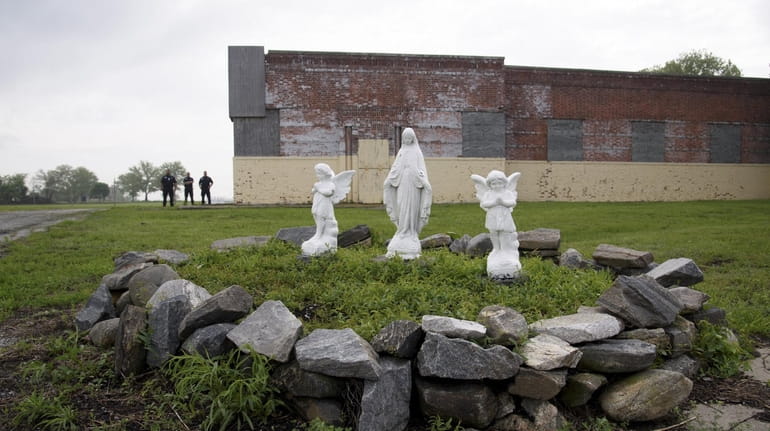De Blasio signs law making Hart Island, NYC's potter's field, a public park

Three religious statues near the ferry dock Wednesday on Hart Island in the Bronx. Credit: Charles Eckert
Hart Island, the largest public cemetery in the nation, with remains of an estimated one million people, became a New York City park Wednesday as Mayor Bill de Blasio signed a law giving the Department of Parks and Recreation control of the Bronx landmark.
With the stroke of a pen, de Blasio made the one-square-mile slice of land a public space and ended decades of control of the island by the city's Department of Correction, which had restricted access and used inmate volunteers as gravediggers. The burials, stretching back to 1869, were of deceased who were both identified and unknown.
The mayor also signed related legislation, including a companion measure tasking the city Department of Transportation with devising more extensive ferry service to the island for the public. Currently, access is available from one dock on City Island operated by correction officials.
"A lot of people said for years this was something the city had to approach from a very different manner," said de Blasio, referring to years of complaints about lack of easy public access to Hart Island. The complaints sparked litigation that eventually led to greater public access to the island in 2014.
"We are at the point where we are going to do things very differently," de Blasio added, calling the new laws a moment of "transformation."
Some changes are still being developed. Melinda Hunt, head of the non-profit Hart Island Project, said other legislation signed by de Blasio on Wednesday asks the city to study how to handle future burials and possibly open the island up for a city owned crematory. City burials would be permitted at least until July 2021, Hunt said.
Hart Island, also known as the city's potter's field, a place serving as the final resting place for those who died without families or were indigent. Others buried there were unknown and consigned to mass graves with markers indicating the burial of 150 bodies. In some cases, early victims of the AIDS epidemic were buried in a separate area.
Positioned at the western end of Long Island Sound, Hart Island served at various times as a military installation and correctional facility. Old buildings, including a church, are in various stages of disrepair.
Superstorm Sandy eroded the coastline and exposed human remains on the northeast edge of the island. In 2018, Newsday reported on the way the remains were being exposed. Soon after, City Councilmen Ydanis Rodriguez (D-Manhattan) and Peter Koo (D-Flushing) crafted some of the legislation de Blasio signed into law Wednesday.

